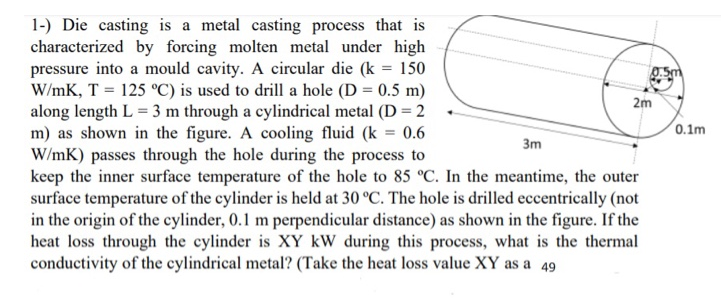1-) Die casting is a metal casting process that is characterized by forcing molten metal under high pressure into a mould cavity. A circular die (k = 150 W/mK, T = 125 °C) is used to drill a hole (D = 0.5 m) along length L = 3 m through a cylindrical metal (D = 2 m) as shown in the figure. A cooling fluid (k = 0.6 W/mK) passes through the hole during the process to keep the inner surface temperature of the hole to 85 °C. In the meantime, the outer surface temperature of the cylinder is held at 30 °C. The hole is drilled eccentrically (not in the origin of the cylinder, 0.1 m perpendicular distance) as shown in the figure. If the heat loss through the cylinder is XY kW during this process, what is the thermal conductivity of the cylindrical metal? (Take the heat loss value XY as a 49 2m 0.1m %3D 3m
1-) Die casting is a metal casting process that is characterized by forcing molten metal under high pressure into a mould cavity. A circular die (k = 150 W/mK, T = 125 °C) is used to drill a hole (D = 0.5 m) along length L = 3 m through a cylindrical metal (D = 2 m) as shown in the figure. A cooling fluid (k = 0.6 W/mK) passes through the hole during the process to keep the inner surface temperature of the hole to 85 °C. In the meantime, the outer surface temperature of the cylinder is held at 30 °C. The hole is drilled eccentrically (not in the origin of the cylinder, 0.1 m perpendicular distance) as shown in the figure. If the heat loss through the cylinder is XY kW during this process, what is the thermal conductivity of the cylindrical metal? (Take the heat loss value XY as a 49 2m 0.1m %3D 3m
Elements Of Electromagnetics
7th Edition
ISBN:9780190698614
Author:Sadiku, Matthew N. O.
Publisher:Sadiku, Matthew N. O.
ChapterMA: Math Assessment
Section: Chapter Questions
Problem 1.1MA
Related questions
Question

Transcribed Image Text:1-) Die casting is a metal casting process that is
characterized by forcing molten metal under high
pressure into a mould cavity. A circular die (k = 150
W/mK, T = 125 °C) is used to drill a hole (D = 0.5 m)
along length L = 3 m through a cylindrical metal (D = 2
m) as shown in the figure. A cooling fluid (k = 0.6
W/mK) passes through the hole during the process to
keep the inner surface temperature of the hole to 85 °C. In the meantime, the outer
surface temperature of the cylinder is held at 30 °C. The hole is drilled eccentrically (not
in the origin of the cylinder, 0.1 m perpendicular distance) as shown in the figure. If the
heat loss through the cylinder is XY kW during this process, what is the thermal
conductivity of the cylindrical metal? (Take the heat loss value XY as a 49
2m
0.1m
%3D
3m
Expert Solution
This question has been solved!
Explore an expertly crafted, step-by-step solution for a thorough understanding of key concepts.
Step by step
Solved in 3 steps with 3 images

Knowledge Booster
Learn more about
Need a deep-dive on the concept behind this application? Look no further. Learn more about this topic, mechanical-engineering and related others by exploring similar questions and additional content below.Recommended textbooks for you

Elements Of Electromagnetics
Mechanical Engineering
ISBN:
9780190698614
Author:
Sadiku, Matthew N. O.
Publisher:
Oxford University Press

Mechanics of Materials (10th Edition)
Mechanical Engineering
ISBN:
9780134319650
Author:
Russell C. Hibbeler
Publisher:
PEARSON

Thermodynamics: An Engineering Approach
Mechanical Engineering
ISBN:
9781259822674
Author:
Yunus A. Cengel Dr., Michael A. Boles
Publisher:
McGraw-Hill Education

Elements Of Electromagnetics
Mechanical Engineering
ISBN:
9780190698614
Author:
Sadiku, Matthew N. O.
Publisher:
Oxford University Press

Mechanics of Materials (10th Edition)
Mechanical Engineering
ISBN:
9780134319650
Author:
Russell C. Hibbeler
Publisher:
PEARSON

Thermodynamics: An Engineering Approach
Mechanical Engineering
ISBN:
9781259822674
Author:
Yunus A. Cengel Dr., Michael A. Boles
Publisher:
McGraw-Hill Education

Control Systems Engineering
Mechanical Engineering
ISBN:
9781118170519
Author:
Norman S. Nise
Publisher:
WILEY

Mechanics of Materials (MindTap Course List)
Mechanical Engineering
ISBN:
9781337093347
Author:
Barry J. Goodno, James M. Gere
Publisher:
Cengage Learning

Engineering Mechanics: Statics
Mechanical Engineering
ISBN:
9781118807330
Author:
James L. Meriam, L. G. Kraige, J. N. Bolton
Publisher:
WILEY